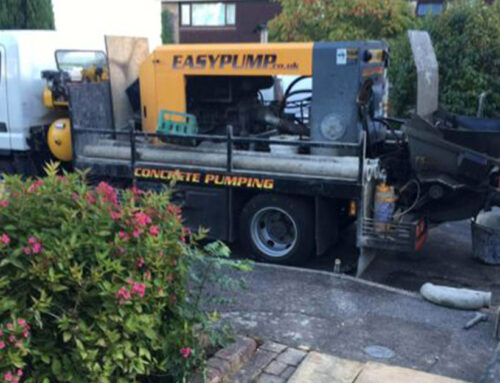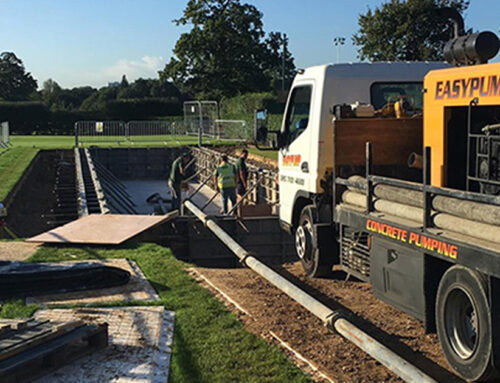Welcome to Easypump, your top choice for concrete pumping solutions! We’re exploring the key differences between boom pumps and line pumps today. Knowing these differences helps you pick the best equipment for your building work, making sure ensuring it’s done efficiently and cost-effectively.
What is a Boom Pump?
A boom pump is a big concrete pump mounted on a truck, featuring a remotely controlled robotic arm, called a boom, for precise concrete placement. It’s perfect for big construction jobs like skyscrapers, vast concrete areas, or places hard to reach. This pump can stretch over barriers and pump concrete up high or down deep, making it flexible for challenging sites.
Key Features of Boom Pumps
- High Reach and Volume: Boom pumps can reach heights of over 100 meters, making them perfect for tall structures.
- Speed and Efficiency: With the capacity to pump large volumes of concrete quickly, they significantly reduce pouring time.
- Precision Placement: The robotic arm can be maneuvered with great precision, minimising labor and reducing waste.
What is a Line Pump?
A line pump, on the other hand, is a portable unit that pumps concrete through hoses laid along the ground. It is typically mounted on a trailer or a truck and uses flexible or steel hoses to pump concrete to the desired location. Line pumps are best suited for smaller projects like residential driveways, sidewalks, or swimming pools.
Key Features of Line Pumps
- Flexibility and Accessibility: Line pumps can navigate through narrow spaces and over rough terrain.
- Cost-Effective: They are more economical for smaller projects due to lower operational and setup costs.
- Controlled Flow Rate: Ideal for projects that require a slower, more controlled pour, reducing the risk of forming air pockets.
Read also: Line and Boom Pump: The Convenient Concrete Layering Tools
Differences Between Boom and Line Pumps
- Scale and Usage: Boom pumps are designed for large-scale projects requiring high volume and reach. Line pumps are better suited for smaller, more precise applications.
- Mobility and Setup: Boom pumps require larger setup areas and are less mobile on site compared to the compact and maneuverable line pumps.
- Cost Implications: The operational cost of boom pumps is higher, reflecting their larger scale and efficiency in big projects. Line pumps offer a cost-effective solution for smaller jobs.
- Versatility: While boom pumps can navigate over obstacles and pump to great heights, line pumps are unmatched in their ability to access tight and confined spaces.
- Pouring Speed and Volume: Boom pumps deliver concrete faster and in larger quantities than line pumps, which provide a more measured and controlled flow.
Choosing the Right Pump for Your Project
Choosing the right pump for your project involves considering the size of the project, how easy it is to access the site, how much concrete you need, and your budget. If you’re working on a big project and have issues with site access, a boom pump is ideal. However, if your project is smaller and more intricate with limited space, a line pump would be better and more affordable.
Conclusion
At Easypump, we offer both boom and line pumps to cater to the diverse needs of our clients. Understanding the difference between these two types of pumps is crucial for making an informed decision and ensuring the success of your construction project. Our team of experts is always ready to provide guidance and support, ensuring you select the perfect pump for your needs.
In conclusion, if you need the extensive reach of a boom pump or the precise and accessible features of a line pump, easypump.co.uk has the right tools and knowledge to support your construction needs.
Get in touch with us today to learn more about our services and how we can help with your upcoming project!
You can also read: Concrete Pump Hire: Everything You Need to Know
FAQs:
1. What are the main advantages of using a boom pump?
Boom pumps offer significant advantages in terms of reach and volume, making them ideal for large-scale construction projects. Their high reach and fast pumping capabilities allow for efficient concrete placement in tall or expansive structures, while their precise control reduces labor and waste.
2. Can line pumps handle the same volume of concrete as boom pumps?
No, line pumps are designed for smaller projects and typically have a lower volume capacity compared to boom pumps. They are best suited for applications where precision and accessibility in confined spaces are priorities, such as residential or small-scale commercial projects.
3. How do I decide between renting a boom pump and a line pump for my project?
The choice between a boom and a line pump depends on the project’s scale, site accessibility, and concrete volume requirements. For large, open sites needing high volumes of concrete, a boom pump is more suitable. For smaller projects or areas with limited access, a line pump would be the better choice.
4. Are boom pumps more expensive to operate than line pumps?
Yes, generally, boom pumps are more expensive to operate due to their larger size, higher capacity, and the complexity of their operation. They are typically used for projects where their efficiency and capabilities can justify the higher cost.
5. Can a line pump be used for a high-rise building project?
Line pumps are not usually suitable for high-rise building projects due to their limited reach and lower pumping capacity. High-rise projects typically require the extended reach and power of a boom pump to efficiently transport concrete to greater heights.
6. Does EasyPump.co.uk provide operators for the pumps?
Yes, EasyPump.co.uk provides experienced and trained operators for both boom and line pumps to ensure efficient and safe operation during your construction project. Our team is equipped to handle the setup, operation, and troubleshooting of the pumps, ensuring a smooth and effective concrete pouring process.


